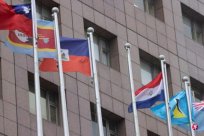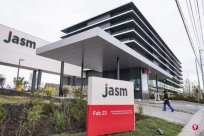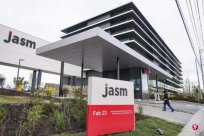
The Kumamoto Factory (JASM), which is a joint venture between the Taiwan Style Circuit Manufacturing Corporation (TSMC) and the Japanese company, opened on the afternoon of Saturday (February 24) to catch up with the US factory in Tenki Power.factory.
This is the milestone of TSMC's first wafer fab and entered the trial production after the Cold War of China and the United States launched the Cold War of China and the United States.Kumamoto Plant is a joint venture project of TSMC and Japanese companies Sony and Toyota Motor Company.
TSMC Kumamoto Plant is located in Kuoyangcho, Kumamoto Prefecture. It started in April 2022. It was one year a year later than the project started in Phoenix in Phoenix, Arizona in April 2021, but it was completed in 22 months.On the other hand, the progress of the US factory has repeatedly delayed and is expected to operate in the first half of next year.
Significantly simplify the administration of the construction plant allows the whole year's endless construction
The founding of the wafer fab is generally three to five years. In order to revitalize the semiconductor industry, the Japanese government greatly simplifies the administrative procedures of the Kumamoto Plant and allows construction throughout the year.
At the opening ceremony, the Japanese Prime Minister Kishita Tianshio announced the support of the Kumamoto Factory through a pre -record video.After the Japanese Economic and Industry Minister, Saito Jian revealed that the government has subsidized 732 billion yen (S $ 6.53 million).In addition, Japan has announced earlier that it provides 476 billion yen for Kumamoto Factory, and the government subsidies of the two factories are as high as 1.238 trillion yen.
Zhang Zhongmou, founder of TSMC, said in his speech that I believe that Kumamoto Factory can further enhance the toughness of the wafer supply chain and bring a new wave of revival to the Japanese semiconductor industry.He said that with the development of artificial intelligence, the production capacity of millions of wafers will be produced in the future, and even more wafer factories are stained.TSMC Chairman Liu Deyin, President Wei Zhejia, and senior executives of the joint venture Japanese companies also attended the opening ceremony.
Because of concerns that Taiwan was captured by mainland China, the global supply chain was cut off. In recent years, TSMC sought to set up overseas factories to decentralized risks and announced that it was settled in the United States, Japan and Germany.
TSMC is an advanced process chip of more than half of the global production of more than half of the global semiconductor chip (mainland chip) and more than 90 % of the advanced process chips.In order to improve the core requirements of the computing speed of mobile phones, computers, military and artificial intelligence, the Group is currently developing chips below the nano (NM) process.
One nanometer is one -million -millimeter, and the nail -sized two -nanometer process chip can accommodate more than 50 billion crystals (also known as crystal tube).The more transistors, the faster the operation speed and the more electricity saving.
TSMC Kumamoto No. 1 Factory will mass -produce mature process chips such as 28 nanomes, 16 nanometers, and 12 nanometers at the end of this year. The Kumamoto Second Factory plans to produce advanced chips with six nanometers. It is estimated that it will start at the end of this year and operate in 2027.Two factories will provide high -tech chips directly for Sony and Toyota Motors.
Recently, the wave of artificial intelligence has pushed up the global stock market. TSMC's stock price once rushed to NT $ 709 (about S $ 30). Taiwan, Japan, and the US stock market continued to rewrite their historical highs this week.Among them, the Nikkei index rose to 39098 points on Friday, and rewritten the historical high at the end of the year, which is also the turning point of the Japanese economy from prosperity to decline.
However, TSMC also faces many challenges, including Kumamoto in the earthquake belt, and must take shockproof measures.Japanese and Taiwan society also faces the lack of workers derived from young children and super -aged, and must be planned to train semiconductor talents in Japan.
Experts: Kumamoto SUF indicator significance for localized production enhances supply chain toughness
Internationally, the outsourcing of key industries from time to time may weaken Taiwan's competitiveness.In this regard, Chen Ziang, a senior semiconductor industry consultant, pointed out in an interview with Lianhe Morning Post that under geopolitical considerations, TSMC must echo the customer's requirements to strengthen the layout of the toughness of the supply chain.Every day is in war, and there are also US bases to be available.
Chen Ziang believes that the indicator significance of the Kumamoto Plant is that TSMC has enhanced the toughness of the supply chain by being close to the market and joint venture with customers.
Last October, Zhang Zhongmou predicted that Taiwan in the next 20 years in TSMCIn the face of the dilemma of lack of land, water and electricity, and technical talents, the future advantage is no longer .Chen Ziang pointed out that as long as TSMC has left Taiwan on the premise of the most advanced technology, it will be moved in advance. With the help of overseas resources and leverage, it can also pull with customers and reciprocate and benefit.
In recent years, competition between China and the United States has exacerbated the risk of the Taiwan Strait. Originally, he was highly concentrated in Taiwan, serving the world's semiconductor and precision mechanical manufacturers. From the end of 2022, he has been looking for another production base outside Taiwan to decentralized risks.TAIWAN + 1) In the new trend, India and Southeast Asia have become a key area of the risk of transfer due to talent quality and relatively stable, while Japan is not a popular place.
Chen Ziang analyzed that the "Taiwan Plus One" decentralized risk strategy has entered the mainland from the early west, to the south to Southeast Asia and "eastward north", that is, enter the United States east, and go north to the northGo to Japan and Europe.He believes that Taiwan -Japan work culture is similar and harmonious in labor and capital, which is more suitable for the development of wafer factories than Europe and the United States.




